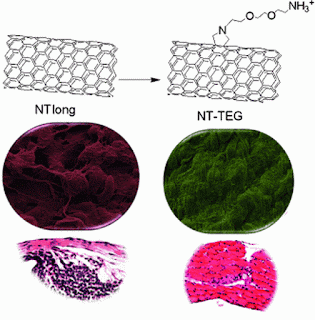Nanotubes the world's darkest known substance, to make an ultraefficient, highly accurate optical power detector.
The National Institute of Standards and Technology (NIST) has demonstrated a novel chip-scale instrument made of carbon nanotubes that may simplify absolute measurements of laser power, especially the light signals transmitted by optical fibers in telecommunications networks.
The prototype device, a miniature version of an instrument called a cryogenic radiometer, is a silicon chip topped with circular mats of carbon nanotubes standing on end.* The mini-radiometer builds on NIST's previous work using nanotubes, the world's darkest known substance, to make an ultraefficient, highly accurate optical power detector,** and advances NIST's ability to measure laser power delivered through fiber for calibration customers.***
The versatile nanotubes perform three different functions in the radiometer. One VANTA mat serves as both a light absorber and an electrical heater, and a second VANTA mat serves as a thermistor (a component whose electrical resistance varies with temperature). The VANTA mats are grown on the micro-machined silicon chip, an instrument design that is easy to modify and duplicate. In this application, the individual nanotubes are about 10 nanometers in diameter and 150 micrometers long.
By contrast, ordinary cryogenic radiometers use more types of materials and are more difficult to make. They are typically hand assembled using a cavity painted with carbon as the light absorber, an electrical wire as the heater, and a semiconductor as the thermistor. Furthermore, these instruments need to be modeled and characterized extensively to adjust their sensitivity, whereas the equivalent capability in NIST's mini-radiometer is easily patterned in the silicon.
NIST plans to apply for a patent on the chip-scale radiometer. Simple changes such as improved temperature stability are expected to greatly improve device performance. Future research may also address extending the laser power range into the far infrared, and integration of the radiometer into a potential multipurpose "NIST on a chip" device.
###
* N.A. Tomlin, J.H. Lehman. Carbon nanotube electrical-substitution cryogenic radiometer: initial results. Optics Letters. Vol. 38, No. 2. Jan. 15, 2013.
* N.A. Tomlin, J.H. Lehman. Carbon nanotube electrical-substitution cryogenic radiometer: initial results. Optics Letters. Vol. 38, No. 2. Jan. 15, 2013.
** See 2010 NIST Tech Beat article, "Extreme Darkness: Carbon Nanotube Forest Covers NIST's Ultra-dark Detector," at www.nist.gov/pml/div686/dark_081710.cfm.
***See 2011 NIST Tech Beat article, "Prototype NIST Device Measures Absolute Optical Power in Fiber at Nanowatt Levels," at www.nist.gov/pml/div686/radiometer-122011.cfm.
Contact: Laura Ost laura.ost@nist.gov 303-497-4880 National Institute of Standards and Technology (NIST)























